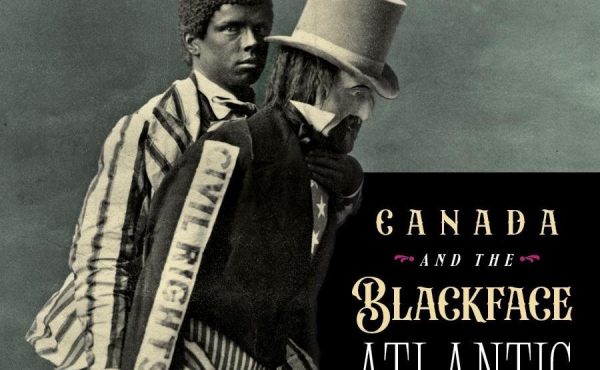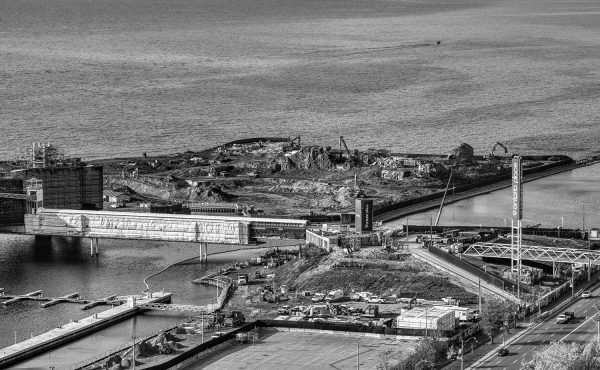
Spacing’s transit contributor James Bow recently wrote about the Save the TTC Signs which includes preserving the signage system at St. George Station created by noted Canadian graphic designer Paul Arthur. As part of the the TTC’s plan to to clean-up stations the signage system was to be removed. Instead, “direction has been given to staff to leave the Paul Arther signage in place until St. George is schedule for renovation under the station modernization program. It’s not in the schedule yet, so it will likely be there for a good while longer, unless direction is given otherwise.”
Keeping it place is fine, but eventually it should be removed to coincide with the implementation of a properly tested signage system across the TTC. Now that the preservation is on the radar, the TTC can look to for a suitable home for Arthur’s orphan wayfinding system.
photo courtesy of Joe Clark




24 comments
It is premature for a third party, particularly this one, to declare victory for me and on my behalf on my issue.
Whenever you talk to TTC about signage, they never answer your question. It’s like talking to a cultist; every answer is about Yahweh or whatever. This is a case in point. Nobody asked about what would happen to the Paul Arthur signs upon station “modernizationâ€Â; St. George is scheduled to be cleaned, not “modernized.†It’s an answer to a question we didn’t ask.
The objective was to avoid the destruction of signs, not necessarily preserve one-off prototypes in place for 14 years, and now apparently longer.
The answer here avoids all the other topics of discussion, too. If I come to a public institution with three or four topics, what I don’t expect is to have only one of those topics half responded to. That isn’t “victory.†And as somebody else mentioned, one person shouldn’t have to put in six months of volunteer effort on a topic like this, particularly given the rather scant results. The goal of this enterprise was not to put preservation “on the radar.â€Â
I would appreciate it if the proponent of the issue were allowed to decide if and when victory were attained. Spacing really isn’t in a position to decide.
This seems more of an “update” post rather than a declaration of victory.
The Yahweh point is funny though.
There are a few points here:
Some of the original Paul Arthur signage is long gone from the station. Only the bands (such as above) and the dragon logo at the Bedford entrance survive. Readers unfamiliar with the station may get the impression from other posts that the entire set of Arthur’s designs remained in place and were about to be removed.
Also, note that the yellow band shown above changes the colour scheme from the original version of the station which had a green band of tile (still under the yellow band) in this location.
Good to hear. The TTC needs to understand how important preserving historical signage, stations, maps, etc are to the civic history of this city.
Not sure what Clark is talking about “victory”. A quick read of the post reveals the word was never used.
Steve:
There are other signs still in place.
Wow, Steve Munro actually responded to the signage issue. He kind of gets it all wrong, but at least he responded.
Ostensibly the YUS and BD lines are colour-coded. Ostensibly so are Sheppard and Scarborough. But three out of four of those colours are confusable to colourblind people, and before Paul Arthur came along, nobody was seriously using the line colours as actual identifiers. The green tile strapline atop the large tiles on both levels of St. George is no kind of indicator; Arthur’s straplines were. The green is merely a concidence in one direction and misleading in another direction.
Arthur addressed the problem of colour deficiency by naming the lines (Green Line) and also giving them numbers. Not every sign had every redundancy, but they were at least available. Oh, another failing of the Sheppard “system”: What is the exact name of the colour of that line? And yeah, where did all the *other* Paul Arthur signs go? If only the head of library and archives at the ROM would deign to respond. Maybe they’re there.
The Sheppard line is purple, I imagine.
The best comment I have heard about Sheppard was on opening day when someone commented that it was the … wait for it …
Plum Line.
I am not sure how I can “kind of” get it all wrong, and have spent some time over the past weekend sorting out fact from fiction on this whole issue.
The Eglinton Station issue was misrepresented in many posts elsewhere. The TTC is not removing entire walls, but is creating alcoves in the existing walls where workers can stand clear of passing trains. This should leave the existing walls largely intact complete with their original “Eglinton” lettering.
The green strapline at St. George was never intended to indicate the line it was on — it was part of the overall original design of station colouring with a top bar using the same colours, in reverse, from the wall and lettering below. This was even retained, after a fashion, in a few of the rebuilt Yonge stations like Summerhill and St. Clair, and is visible with the original strapline at Queen (although the tiles below have been changed).
The only other non-standard signs at St. George are the large route maps that became part of the Sheppard design.
As for colouring and numbering the lines, how many separate naming schemes are we going to have? A colour, a number, a name and maybe even a pictograph for each line?
I have to ask: if the Arthur signage had caused a wholesale replacement of the historic 1950s signs, would we be justified in opposing it on historic grounds or supporting it for legibility and accessibility? Sometimes the two collide.
Also, considerable violence has been done to the look and feel of stations by the introduction of large advertising panels. Should these be removed in the name of historical integrity of the station designs?
Joe Clark is welcome to his opinion, but he does his position no favours by making the arguments ad hominem rather than stating his case clearly and dispassionately. Many, many people in Toronto care about a lot of things, and none of us is the sole expert on any of them.
The only other non-standard signs at St. George are the large route maps that became part of the Sheppard design.
Not correct. There are (1) old 1960s-era signs, (2) 1970s-era Spadina style signs in Univers, (3) Old Paul Arthur signs, (4) A mid-1990s platform edge sign in a pseudo-Sheppard style with misrendered Arial, (5) Some Sheppard-style signs, and (6) a few other signs that are one-offs that match nothing. Almost none of the signs at St. George are “standard.” St. George is a complete and utter mess.
As for colouring and numbering the lines, how many separate naming schemes are we going to have? A colour, a number, a name and maybe even a pictograph for each line?
And maybe an official song and animal and sport for each line? THAT WOULD BE SO CRAZY!!!!
The Arthur scheme assigned a colour and a number to each line. Of course, nobody is advocating any particular scheme (except to point out that the Arthur scheme was measurably better than the horrible non-system in place currently); what’s being advocated is the study and design of a new, *tested* system.
I have to ask: if the Arthur signage had caused a wholesale replacement of the historic 1950s signs, would we be justified in opposing it on historic grounds or supporting it for legibility and accessibility? Sometimes the two collide.
That’s a straw man. Joe Clark isn’t opposing the removal of the Arthur signs, he’s opposing the destruction of them. As for your analogy, a wholesale replacement of the 1950s signs, few of which remain at St. George, could well have been supported on accessibility grounds; testing showed them to be superior.
Also, considerable violence has been done to the look and feel of stations by the introduction of large advertising panels. Should these be removed in the name of historical integrity of the station designs?
Joe Clark has actually advocated removal of advertising.
As my final clarifying comments:
I am trying to debate the issues, not Joe Clark or his particular take on them.
My point about Arthur’s signs was not a straw man, but to show that they are one in a series of violations of the original look and feel of the station. Yes, they had a specific purpose and are therefore of more than passing interest, but I repeat the question: if someone proposes a new style of signage supported by all the studies in the world, should it be implemented in place of what is there today? Should, for example, an Arthuresque yellow band replace the black vitrolite band at Eglinton Station if that were the new standard?
I did not intend to imply that somehow the signs at St. George followed some sort of standard, but they are the usual mish-mash found all along the Bloor line. The sole exception is the hanging map that was put up at about the same time as the Arthur signs, and which became the precursor to the Sheppard “style”.
Enough already!
They should just test the current system. Only then will they be able to hush down the naysayers. Advertising presents a great challenge to see what kind of poster you can get away with. Eventually, you have free wallpaper.
But I’d like to see more postering spaces in the TTC. I also heard something about neon lights on the exteriors of station for the station name. I don’t support this idea. Even 7-11 doesn’t use those things, they’ve got class.
Hopefully I didn’t dream that last bit, I’m pretty confident about the other stuff.
What about our messy heritage? I’m going to lobby for a 7-freakin 11 at yonng and bloor. Dey gawt it goin o-n!
if someone proposes a new style of signage supported by all the studies in the world, should it be implemented in place of what is there today? Should, for example, an Arthuresque yellow band replace the black vitrolite band at Eglinton Station if that were the new standard?
If such a change were demonstrably justified on the basis of superior performance, then I would say yes. Who says that the black Vitrolite band couldn’t be removed and preserved?
Of course, if testing showed that the yellow band wasn’t useful or effective, then one would have to weigh the various factors – consistency, historical preservation, etc. Your hypothetical question can’t be answered in the absence of data.
If the new system says that the a yellow band is so effective that it outweighs the need for historical preservation, then it should be put up. I would question that a study would, but that’s not the issue.
Enough already!
No, it’s not enough already.
The increasingly testy Steve Munro misses the point that Arthur’s straplines sat on top of the living tile. There was no destruction or replacement involved – not of any permanent TTC structure, in fact, save for exterior signage.
Hence, if the whole system had been implemented circa 1994 and now, in 2007, further research and testing showed that we needed something new and better, we could remove the Arthur straplines and reveal the old tile strips… which we could then cover up with a new sign system.
Really, now. I am a big defender of the bathroom-tile station à ¦sthetic (it’s honest about what it is), but covering up one strip that gives the name of the station with another strip that gives the name of the station in a form people can actually read is nothing to worry about.
Also, I have been considerably underplaying my annoyance and deflation at Blackett’s taking over my issue, despite his evident good intentions. This thing has not been settled yet.
Joe, I haven’t taken over anything. How is making a post taking over an issue? Am I not allowed to ever say anything about a campaign or issue you’re involved in? Should I not speak to staff and commissioners I have developed relationships with to help advance *your cause*?
I made a post about it *in support* of your campaign and answered a few questions directed at me from the media (James Bow would’ve done the follow-up post but since his in middle-America I did it instead). I’ve done everything to make sure that people know this is your campaign. Your massive insecurity is unfounded.
Thickslab makes the point that any design which is proposed to replace an existing one, especially one with historic importance, needs to demonstrably (by some measure) be an improvement warranting the change.
All that is needed is agreement about how to measure the tradeoffs, and that is rather difficult to achieve as this discussion has shown.
As for preservation vs retention in situ, the former loses the context. It would be rather like looking at a single column of the Parthenon after the building was demolished to make way for a condo. If I want to see historic tiles, I should be able to do so in a real subway station.
Of course, a good designer would take the need to accommodate existing, preservation-worthy uses in their new design rather than just plastering a bunch of new signs over the old ones.
All that is needed is agreement about how to measure the tradeoffs, and that is rather difficult to achieve as this discussion has shown.
It’s not, actually. What’s difficult is trying to agree with it on an internet discussion board. The comments section of a blog is not the place for weighing multiple factors re: wayfinding design and historical preservation. That’s best left to experts, supplemented by lots of testing and extensive public consultation.
As for preservation vs retention in situ, the former loses the context. It would be rather like looking at a single column of the Parthenon after the building was demolished to make way for a condo. If I want to see historic tiles, I should be able to do so in a real subway station.
Historic tiles, as wonderful as they are, are not the Parthenon. Removing subway tiles to place them on display at a museum is hardly the same as demolishing the Parthenon to make way for a condo. Seriously, now.
Should I not speak to staff and commissioners I have developed relationships with to help advance *your cause*?
If I may presume to comment here, I think what Joe is concerned is that involvement by a group that has proven ineffective in the past (i.e., the street furniture contract) might end up being counterproductive.
Ha!
Is anyone else amused by the fact that 100% the commenters here support the cause, but still Joe Clark has managed to alientate, piss off and write condescendingly towards his supporters?
Excellent way to build a groundswell of support!
PS: he must’ve been an NDP strategist from the 90s.
Yes, I can see the similarities in preserving TTC signs and fighting a $400-million dollar contract and an multi-billion dollar industry with paid lobbyists. I can also clearly see how having well-respected advocates backing up a worthy cause would be counter-productive.
Sigh.
Kim, are you implying that NDP strategy has changed since the 90s?
I tried reading the clark blog before, but I could not get beyond the anger and approach he takes, so I forgot about that website. If not for the two links in this post that directly link to his site on this issue (which only a paranoid would interpret as stealing) I’d have never known about this issue because I don’t want to read material from a person like this guy. Maybe he does good work, but with people like him, as it seems with this constantly posting thickslab, you’d never know people are on the same side. Thickslab, hamish wilson….i just see the names and skim to the next poster. So much to say, wow.
Keep up the good work everybody else, anyway.
“this constantly posting thickslab”
LOL.
This is the dumbest cause by far taken up by the Toronto activist community. The ugly, dirty tiles and old signs in most TTC stations are not a part of our heritage. You’re all just being sentimental.
The dumbest? Of all time?
Hey, Angela, who said anything about stealing?
Yours angrily –